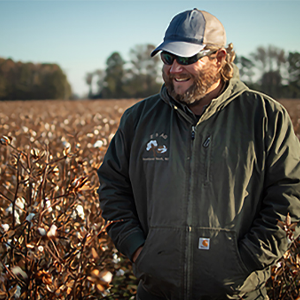Zeb Winslow

Farmer Mentor in 2019-20 and 2023-24
Scotland Neck, North Carolina
Zeb Winslow is an SHI Farmer Mentor for North Carolina. To see other SHI Soil Health Educators, Technical Specialists, and Farmer Mentors who are located throughout the U.S. Cotton Belt, please visit our Contacts page.
Zeb is a 5th generation farmer from Scotland Neck, North Carolina, who started his soil health journey by taking lessons from his dad when he began growing cotton using a strip till system after working with the Fishing Creek Soil and Water Conservation District (SWCD) in the late 1990’s. This system incorporated a cereal grain cover crop, which was terminated early to keep it from growing too tall. Today on his 800-acre farm, Zeb uses a diverse rotation that incorporates corn, soybeans (full season and double crop), wheat, and cotton along with no-till planting and diverse cover crop mixes.
Soil Health Management System
Zeb’s soil health management system addresses all four of the soil health principles that include maximizing diversity, minimizing disturbance, keeping living roots growing and maintaining residue cover. He accomplishes this by maintaining a diverse crop rotation that incorporates cover crops along with no-till planting of all his crops. In addition, Zeb follows a nutrient management plan and controls pests using integrated pest management (IPM).
Reasons for adopting a soil health management system:
- Grew tired of the “chemical treadmill” – a system of applying nitrogen (N), phosphorus (P) and potassium (K) without knowing if it would work, or using products that promised to pay for themselves but failed to live up to the hype;
- Was looking for a way to control the rising cost of inputs while reducing the impact his farming activities have on the environment; and
- Wanted to develop a farming system that his children can challenge him to improve on before they take over, as he did in bringing new ideas in soil health to his own father. He sees soil health management systems and understanding the interaction between plants and soil as the next frontier of farming.
Soil health benefits observed:
- Improved drainage allows him to get into his fields sooner;
- Removed seasonal variability to provide more consistent yields year to year;
- Mellow ground to plant into;
- Increase in soil organic matter;
- Noticeable difference in how easy the tractor pulled when going through fields where multi-species cover crops were planted;
- More stable fields with no issue of rutting or getting stuck after eliminating subsoiling;
- Increased job satisfaction and enjoyed farming again; and
- More time and interest to “geek out” looking at soil biology while in the field.
Tips for fellow producers on adopting a soil health management system:
- Experiment with new ideas on corn and soybean crops. Cotton is too costly of a crop to try new things on first.
- Play around with small acreage at first rather than the entire farm.
- Use comparison plots to conduct your own research and development (R&D).
- Manage tall cover crops by rolling them to the ground. This makes planting easier.
- Take advantage of Natural Resource Conservation Service (NRCS) conservation programs.
- Make planting of cover crops a priority—get them seeded as soon as possible after a field is harvested then let it grow until you are ready to plant.
Moving forward, Zeb will continue to improve his soil health management system by:
- Paying more attention to weather reports to improve moisture management—doing so gives a better idea as to when to terminate cover crops and how to manage extreme conditions;
- Planting green into living cover crops and not being intimidated by the height of the cover crop;
- Viewing recommendations from cotton scouts as information to consider rather than a recipe to follow;
- Considering the impact that any mitigation activity might have on the soil biology;
- Putting more weight on beneficial pests; and
- Building a network of soil health producers to learn from.